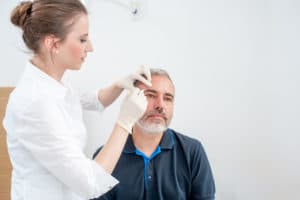Reconstruction after Mohs Surgery, Is it Always Necessary?
- Posted on: Apr 15 2020
- Leave a response

In recent years, we have seen a steep increase in the number of physicians receiving training in Mohs micrographic surgery. While this technique for removing cancerous growths is considered the gold standard, one cannot say with full confidence that every patient who undergoes Mohs surgery will be able to avoid reconstructive surgery. Here, we discuss the Mohs procedure for patients who are seeking information, along with the reconstruction options that may need to be considered.
Mohs Surgery for Skin Cancer
The two most common forms of skin cancer are basal cell carcinoma and squamous cell carcinoma. These conditions are often treated successfully with Mohs surgery. Experienced dermatologists may recommend Mohs for lentigo malignant melanoma when the condition is caught early. This form of melanoma tends to stay close to the skin’s surface for a time. The Mohs technique works by removing a single layer of tissue at a time. The removed tissue is immediately examined under a microscope for evidence of remaining cells. The procedure ends when a removed layer of tissue contains no abnormal cells.
About Reconstruction after Mohs Surgery
One of the reasons why Mohs micrographic surgery is becoming the new norm in skin cancer removal is that this procedure minimizes tissue trauma. Because only a small section of skin is removed at a time, tissue defects are kept to a minimum. Scarring is less, as is the need for reconstruction. However, closure technique matters. Depending on the closure skills of the Mohs dermatologist, a patient may require follow-up with a plastic surgeon.
Post-Mohs reconstruction may involve:
- Flap techniques, especially relevant for facial reconstruction.
- Cartilage grafting, especially relevant for ear reconstruction.
- Bone grafting.
- Tissue expansion.
- Skin grafting, a far less common necessity.
Can Dermatologists Help Their Patients Avoid Reconstruction?
If you are a dermatologist interested in becoming a skin cancer specialist, contact us at (714) 379-6262 or fill out a Contact Form here. If you are a patient looking for a Mohs specialist in your area, search our database here.
Posted in: Mohs Surgery

